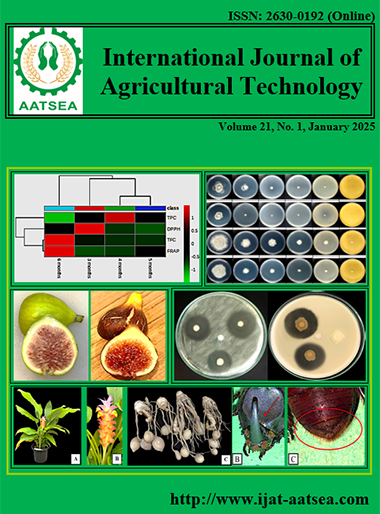Development of a healthier durian cookie enhanced with inulin
Main Article Content
Abstract
Cookies are characterized by their high sugar and fat contents. To enhance their nutritional profile, the incorporation of functional ingredients such as inulin has been proposed. The results indicated that the substitution of durian powder led to a reduction in moisture content, lightness (L*), yellowness (b*), and caloric value, while hardness and redness (a*) increased. The cookies with 20% w/w durian powder exhibited the highest overall acceptability (r≤0.05). Thus, this formulation was selected for further investigation, where sugar was partially replaced with inulin at concentrations of 0%, 20%, 40%, and 60%w/w, respectively. The results demonstrated that the substitution of inulin tended to decrease lightness (L*) and yellowness (b*), while moisture content, hardness, calories, and redness (a*) increased. In sensory evaluation, cookies with 20% w/w inulin supplementation received significantly (r≤0.05) higher scores for taste, texture, and overall liking. Interestingly, the caloric content of the developed durian cookies was significantly lower (r≤0.05) than that of the control cookies. Scanning electron microscope analysis revealed the presence of an inulin gel network within the cookies. In conclusion, this study offers important insights into the development of healthier cookies utilizing low-grade durian, presenting a significant opportunity for food manufacturers to address the current market demand for healthier dietary options.
Article Details

This work is licensed under a Creative Commons Attribution-NonCommercial-NoDerivatives 4.0 International License.
References
Abed, S., Ali, A. H., Noman, A., Niazi, S., Ammar, A. F. and Bakry, A. M. (2016). Inulin as prebiotics and its application in food industry and human health; A review. International Journal of Agriculture Innovations and Research, 5:88-97.
Akram, W., Garud, N. and Joshi, R. (2019). Role of inulin as prebiotics on inflammatory bowel disease. Drug Discoveries & Therapeutics, 13:1-8.
Aziz, N. A. and Jalil, A. M. M. (2019). Bioactive compound, nutritional value, and potential health benefits of indigenous durian (Durio Zibethinus Murr.): A review. Foods, 8:1-18.
Blanco Canalis, M. S., León, A. E. and Ribotta, P. D. (2017). Effect of inulin on dough ang biscuit quality produced from different flours. International Journal of Food Studies, 13-23.
Charoenphun, N. (2018). Development of cookie products from sweet potato, Journal of food technology,Siam university, 13:32-43.
Charoenphun, N. and Kwanhian, W. (2019). Production of Gluten Free Cookies Supplemented with Durian Rind Flour. Science and Technology RMUTT Journal, 9:23-38.
Charat, R., Lertsiri, S. and Tananuwong, K. (2022). Volatile compound production and quality characteristics of Durian fruit cv. Mongthong as affected by 1-methylcyclopropene and modified asmosphere storage. International Journal of Friut Science, 22:481-494.
Devalaraja, S., Jain, S. and Yadav, H. (2011). Exotic fruits as therapeutic complements for diabetes, obesity and metabolic syndrome. Foos Research International, 44:1856-1865.
Dharma, A. and Insani, R. M. S. (2020). Development of Healthier Cookie Product by Utilizing Different Formulations of Durian Seed Flour. Indonesian Journal of Life Sciences, 02:89-95.
Duncan, M. (2011). Mauley’s technology of biscuits, crackers and cookies. Cambridge: Woodhead Publishing Series in Food Science, Technology and Nutrition: Number, 217.
Giarnetti, M., Paradiso, V. M., Caponio, F., Summo, C. and Pasqualone, A. (2015). Fat replacement in Shortbread cookies using an emulsion filled gel based on inulin and extra virgin olive oil. LWT – Food Science and Technology, 63:339-345.
Glibowski, P. and Wasko, A. (2008). Effect of thermochemical treatment on the structure of inulin and its gelling properties. International Journal of Food Science and Technology, 43:2075-2082.
Kolida, S., Tuohy, K. and Gibson, S. R. (2002). Prebiotic effects of inulin and oligofructose. British Journal of Nutrition (Suppl.), 2:s193-197.
Lee, Y. J., Lee, O. H. and Yoon, W. B. (2017). Effect of inulin Jerusalem artichoke (Helianthus tuberosus l.) flour on the Viscoelatic behavior of cookie dough and quality of cookie. Proceedings of the Internation Food Operation and Processing Simulation Workshop. p. 35-44.
Maghaydah, S., Abdul-Hussain, S., Ajo, R., Odeidat, B. and Tawalbeh, Y. (2013). Enhancing the Nutritional Value of Gluten – Free Cookies with Inulin. Advance Journal of Food Science and Technology, 5:866-870.
Mahyiddin, Z., Indani, Suhairi1, L, Ulya, Z. and Munanda, Z. (2020). The addition of nutmeg (Myristica fragrans) essential oil to intensify the aroma as a replacement of rum considering halal supply chain for cookies that use durian (Durio zibethinus) seeds waste-based flour to create sustainable advantages. IOP Conf. Series: Earth and Environmental Science, 956:012007.
Morris, C. and Morris, G. A. (2012). The effect of inulin and fructo-oligosaccharide supplementation on the textural, rheological and sensory properties of bread and their role in weight management: A review. Food Chemistry, 133:237-248.
Pertiwi, E. D., Wijaningsih, W. and Tursilowati, S. (2018). Protein Fat, Carbohydrates and the Acceptance Level toward Durian Seed Flour Cookies. ARC Journal of Nutrition and Growth, 4:2455-2550.
Robert, S. D., Ismail, A. A. S., Winn, T. and Wolever, T. M. (2008). Glycemic index of common Malaysian fruits. Asia Pacific Journal of Clinical Nutrition, 17:35-39.
Shoaib, M., Shehzad, A., Omar, M., Rakha, A., Raza, H., Sharif, H. R., Shakeel, A., Ansari, A. and Niazi, S. (2016). Inulin: Properties, health benefits and food applications. Carbohydrate Polymers, 147:444-454.
Suppramaniam, H., Hussin, N. and Jalil, A. M. M. (2019). Glycaemix index, palatability, acceptability and perceived satiety of cookies prepared with durian (Durio Zibethinus Murr) and β-glucan. Malays. Annals of Apply Biology, 48:89-99.
Tan., C. H., Ishak, W. R. W., Easa, A. M., Hii, C. L., Chuo, K. M. J., How, Y. H. and Pui, L. P. (2023). From waste to wealth: a review on valorisation of durian waste as functional food ingredient. Journal of Food Measurement and Characterization,17:6222-6235. ·
Thammarutwasik, P., Hongpattarakere, T., Chantachum, S., Kijroongrojana, K., Itharat, A., Reanmongkol, W., Tewtrakul, S. and Ooraikul, B. (2009). Prebiotics-A review. Songkranakarin Journal of Science and Technology, 31:401-408.
Watts, B. M., Yumaki, C. L., Jeffery, L. E. and Elais, L. G. (1989). Basic sensory methods for food evaluation.
International Development Research Centre, Ottawa, Canada. p.159.


